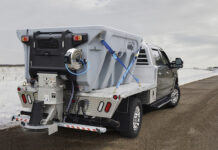Missouri: “I do almost nothing but commercial accounts. It is my first year, so all I have for spraying is a 200-gallon tank sprayer. So, my question is: Where do you fill up your tanks when you are out on the route to save from driving back to the shop? Most of my accounts are close to each other, but are about 15 miles from home. There are gas stations that have water faucets that you can attach a garden hose [to], but I am not sure of the stigma of mixing chemicals at a place where people are and such. What are your thoughts? Most of my accounts are 3 acres and up, and, well, there goes one tank. I have about 70 acres in accounts. Any help is appreciated.”
Minnesota: “Call the city and ask where they would prefer you to fill. Most public works departments allow it on their fill pads.”
Indiana: “Are gas stations OK with you filling up a 200-gallon tank? When I hydroseeded, we would fill at a lake or river with gas-powered pump. (Setting up the pump took longer than filling my 650-gallon tank—about three minutes.) I’d check with DNR first. Here in Indiana, we can do that, but just across the state line in Michigan, it’s forbidden. You definitely get some looks! Oh, and be really careful you don’t overflow and spill.
“Doesn’t answer your question, but if you are doing 70 acres per round, I’d seriously look at a ride-on. You’d be surprised how much time and money you’d save in the long run.”
9: “Go back to the shop and fill. Check your spray calibration. If you’re running out entirely too soon, your rate is off. Never fill up outside of [the] shop. Unprofessional!”
Ohio: “Totally agree! You should never fill up at a customer’s location. Not very professional IMO to do that. I only fill at home.”
Michigan: “Calibration is good; you are probably applying 1.5 gallons per thousand. Of course, you could walk faster, use a smaller nozzle and less pressure, and use 1 gallon per thousand.
“I have a note in my written material. ‘We may need to fill up with water at your location, if you have any concerns about this, please let us know.’
“Of course, you could always add an extra 200-gallon tank—they are cheap. Hope you have good tires; 100 gallons weighs 834 pounds.”
Missouri: “Thanks, I actually never thought about calling the public works in the towns that I have accounts in. I will call them and find out. I will see about fill stations and such. In Lee’s Summit, the town that I do most of my work in, that is not a problem.”
Hurricane Heaven: “Fire stations and fire plugs. You may have to pay a permit fee.
“But, IMHO, it might be time for a bigger truck. Don’t discount a trailer with a larger tank setup. Or, go the Z sprayer route rather than dragging hose on 70 acres.”
New York: “I’m sure wherever you fill, you are using a backflow device.”
Missouri: “Correct, I am using a backflow device. The Z sprayer is a one to two-year down-the-road idea, but I don’t have the cash for it now. I will call fire stations and see what they can do also, thanks again.”
Minnesota: “Fire stations/fire plugs are too much in public view. Most do not have backflow prevention devices or dyked, impervious fill pads and require a permit and meter.
“Fill from a lake or pond? I hope that was just a joke. Not very funny. Someone here may take you seriously.”
Pennsylvania: “I feel guilty filling my 1-gallon hand wash jug at a customer’s property.”
Hurricane Heaven: “Some towns give or sell permits to use public fire plug water. Marco Island, Fla., is one of those towns that sell an unlimited permit. One of my big boy competitors sends a truck inland to service a small town. They tank up at the fire department free of charge. My town has hose bibs on some fireplugs for watering plants nearby. I have tanked off those fireplug hose bibs.
“I have a deep well at my house and save paying for water.”
Southern Indiana: “We have one large industrial [account] where we use their fire hydrants. Otherwise, back at the shop.”
Minnesota: “In Minnesota, we are required by law to use a backflow prevention unit. We also must be on an impervious surface (i.e. asphalt/pavement) with berms to protect against overspill. Floor drains must be plugged. Even if this were not a requirement, it would still be irresponsible to fill anywhere else.
“Ever try to fill your tank with a fire hose using the ‘air drop’ method for backflow prevention? Good way to get wet!”
Northeast Ohio: “I think if you adjust [the] rate per thousand, the 200-gallon would last the day, and you can fill back at the shop at night or in the morning.
“Possibly a small boom-type that goes on a mower. I have one for my walker, and I use it in large areas to stretch the water and to not walk areas that I can ride. It doubles my acreage when used.
“Also, I have seen like mentioned above: a second tank.”
Louisiana: “If you’re trying to hold the fire hose, you would probably get wet, but not if you have a tank-mounted air gap the way you’re supposed to. A hydrant and fire hose was the only way I filled my 900-gallon tree-spraying rig.
“I’ve never done it before, but filling from a lake or pond is legal in many areas.”
Missouri: “So that I am understanding your responses, some of you fill straight from a fire hydrant, the kind that firefighters use when battling a blaze. I guess that you guys turn her on and hold on tight while it throws you through the air. Just kidding, I like the idea about air drops, but that sounds too wet to me.”
Maryland: “We have arrangements with gas stations, commercial customers and local water treatment plant as well. Provide free lawn or tree shrub service to gas station or commercial account for free water. An apartment complex works with us on the water problem in one area.
“We cover most of four different counties an need remote water sources.”











![[VIDEO] Dickies®: Discover Workwear That’s Anything But Uniform](https://turfmagazine.com/wp-content/uploads/2023/06/1647663814-4b1a2a7742790a9b1e97a3b963477850192e1d6a9dfba9b07214a77bae25d6e3-d-218x150.jpg)




























![[VIDEO] Dickies®: Discover Workwear That’s Anything But Uniform](https://turfmagazine.com/wp-content/uploads/2023/06/1647663814-4b1a2a7742790a9b1e97a3b963477850192e1d6a9dfba9b07214a77bae25d6e3-d-324x160.jpg)